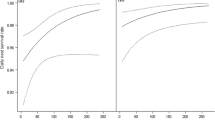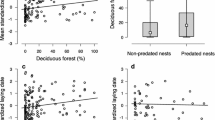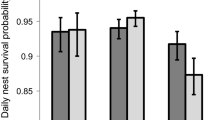Abstract.
Previous studies investigating density-dependent nest predation risk have suffered from unnaturally high nest densities (artificial nests) or lack of controls for nest predator densities (observational data on real nests). I designed an experiment with artificial nests within the natural range of nest densities using a Latin square design (to control for differences in densities of nest predators in time and space) to avoid the shortcomings of previous studies. I incorporated confounding factors, such as time in the breeding season and landscape type, in order to study whether they affected nest predation risk. The experiment was performed in dry semi-natural shrub-rich grasslands in Sweden, using artificial shrub-nests containing two quail (Coturnix coturnix) eggs and a plasticine egg. Finally, I validated my results obtained from the artificial nest experiment by comparing relative nest predation risk on artificial nests with nest predation risk on real nests of red-backed shrikes (Lanius collurio), a shrub-nesting passerine. Corvids were the major nest predators on artificial shrub nests as revealed by marks in plasticine eggs. Within the natural variation in densities of simultaneously active shrub nests, corvids increased their rates of predation with increasing densities of artificial nests, indicating a functional response. Nest predation risk decreased with time in the season and differed between grassland plots in farmland-dominated (high risk), farmland-forest mosaic (low risk), and forest-dominated (low risk) landscape surroundings. Furthermore, predation risk on artificial nests increased with decreasing distance to nests of at least one corvid species. Breeding red-backed shrikes selected grasslands with a low nest predation risk on artificial nests and reproductive success of shrikes was positively related to success of artificial nests. Moreover, the probability of success for both artificial and real red-backed shrike nests increased with increasing distance from the nearest corvid nest. Thus, results from the artificial nest experiment were validated by the results from the red-backed shrike population study. My results therefore suggest that predation risk measured on artificial nests can be used as a relative index of spatial and temporal variation in nest predation risk. My results also indicate that grasslands in forested landscapes should be given extra attention for conservation aspects, since nest predation risk is lower there compared to grasslands in more open habitats.
Similar content being viewed by others
Author information
Authors and Affiliations
Corresponding author
Additional information
Electronic Publication
Rights and permissions
About this article
Cite this article
Roos, S. Functional response, seasonal decline and landscape differences in nest predation risk. Oecologia 133, 608–615 (2002). https://doi.org/10.1007/s00442-002-1056-8
Received:
Accepted:
Published:
Issue Date:
DOI: https://doi.org/10.1007/s00442-002-1056-8




